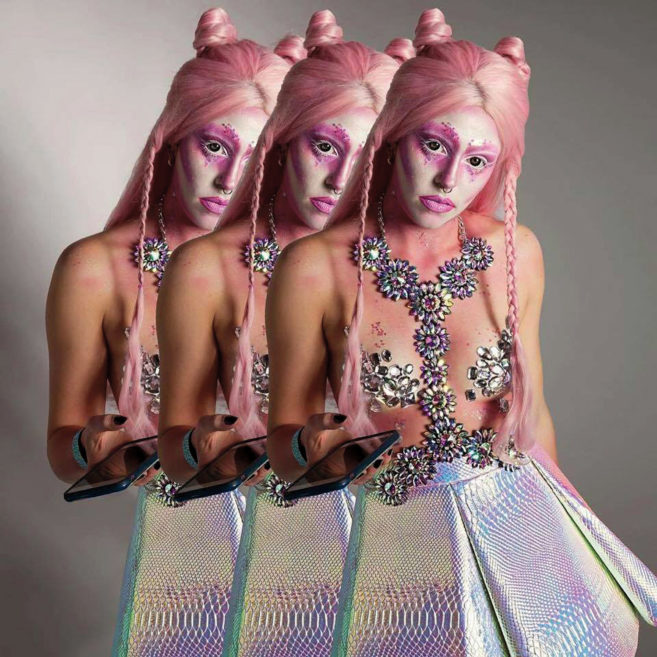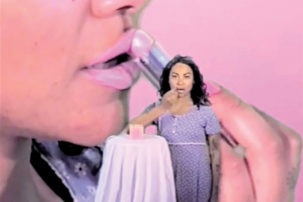Toronto-born artist Victoria Sin has been based in London, UK, for the past decade, where they rose up through experimental and non-binary drag circuits, alongside a burgeoning art practice. During the completion of their MA at the Royal College of Art and in the few years since graduating, Sin’s incorporation of drag into their art practice—which includes moving image, music, original writing and collaborations—is balanced by a careful, intentional refusal of being consumed easily, especially by straight audiences. Their use, exaggeration and transformation of hyper-feminine codes questions ideal images in systems of looking and representation.
Sin has rapidly gained momentum in art contexts, in the past year exhibiting at Chi-Wen Gallery in Taipei, Palais de Tokyo in Paris and the 58th Venice Biennale, as well as hosting the Serpentine Gallery’s podcast in London.
This fall, Sin’s works are presented in Montreal’s MOMENTA Biennale de l’image and MOCA Toronto’s exhibition “Age of You,” curated by Shumon Basar, Douglas Coupland and Hans Ulrich Obrist. Erin Reznick, co-creator of PHILE Magazine, sat down with Sin ahead of the opening of “Age of You” to reflect on the driving forces of their rich speculations.
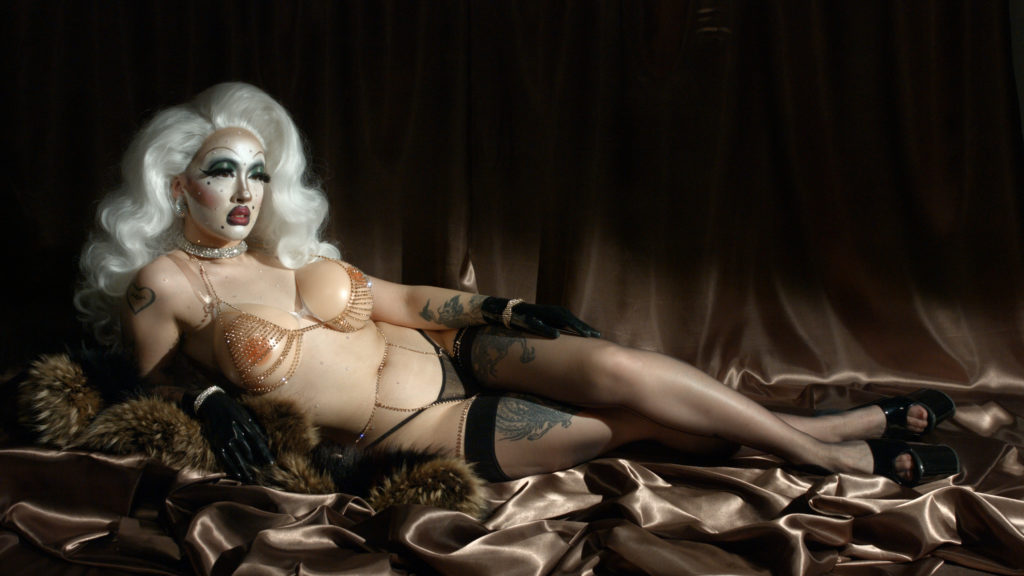
Victoria Sin, Tell me everything you saw, and what you think it means (still), 2018. Single-channel 4K video, 5 min 38 sec. Courtesy the artist/Chi-Wen Gallery.

Victoria Sin, Tell me everything you saw, and what you think it means (installation view), 2018. Courtesy the artist/Chi-Wen Gallery. Photo: Tom Arban Photography Inc.
Erin Reznick: How does it feel to be back in Toronto?
Victoria Sin: It’s a bit weird to be honest. All of my adult life has been in London so whenever I come back to Canada, to Toronto specifically, I revert back to a teenage mindset—I don’t really know how to adult here. This trip is the first time that I’m coming back in a professional context, to show at MOCA and to be part of MOMENTA. It means a lot to me.
ER: How did drag come into your life?
VS: Drag came into my life in Toronto. I was 17 and gay and I used to go to bars on Church Street, Woody’s specifically. Those shows were where I really fell in love with both my queer identity and drag because that was the first time I saw this super empowered embodiment of femininity that was being used to take up space. That was completely mesmerizing for me. At that point I didn’t really realize that I wanted to be a drag queen because I didn’t know that was possible, but I was completely obsessed. That carried over into London where I then met a drag scene that was more open. It wasn’t about trying to perfectly impersonate an idea of what a woman was. It was just about playing with identity constructs. You know, you could do drag as a monster or a bin bag.
ER: When you first started experimenting with drag, did you know you wanted to incorporate it into an art practice?
VS: No, I started doing drag around the time of my undergrad, but [art and drag] were completely separate things. Drag was a secret desire for me. It was something I felt strongly about and also felt was really precious. I was nervous about bringing it into an art context because the drag scene that I was part of was really focused around intersectional marginalized communities, and the art world usually isn’t.
ER: You now operate in the art world and in a traditional drag circuit, which are very different audiences. How would you describe the difference ways you control your image between these two communities?
VS: Well, my performances in a queer context are more fun. They’re to entertain people. I think working in art contexts has opened up a lot for me in terms of my drag because it’s where I started writing, and playing purely with images. In an art context, I can perform an hour-long piece of writing and also have the audience look at me standing still for five minutes. It invites a different kind of contemplation. People are looking in order to be critical, and also to be entertained a little bit, whereas in a queer cabaret context, people are there to be entertained, and maybe be a little bit critical. People are there for completely different reasons, so I have to be mindful of that.
I’ve been operating less in drag contexts recently because I’ve been interested in making pieces that are not just five-to-ten-minute numbers. I’ve been getting more in depth about writing pieces that are more like speculative fiction, and bringing in things that require much bigger budgets, like theatrical devices, costumes, lighting and instrumentalists. It is really exciting but I will never look down on the drag context I came from, because that was where these ideas and passions were born.
For me, drag is embodied speculative fiction. I think the most important thing about science fiction is that it asks the question, “What if?”
ER: There is an inherent link between queerness and speculative fiction because it uses ideas of the future to reflect on contemporary reality and its alternatives. How does science fiction inform your drag?
VS: For me, drag is embodied speculative fiction. I think the most important thing about science fiction is that it asks the question, “What if?” Drag does that in the same way. Science fiction and speculative fiction have informed my work so much because drag was the first time I was able to step outside of myself. By looking completely different and being able to occupy a completely different, exaggerated positionality, I was able to experience how people treated me differently. So I acted differently. This act of continually putting on and occupying a different position changed not only my ideas about my gender and practice, but myself. It was through this process that I realized I was non-binary. It’s not just that science fiction had an influence on my practice; it’s become my practice.
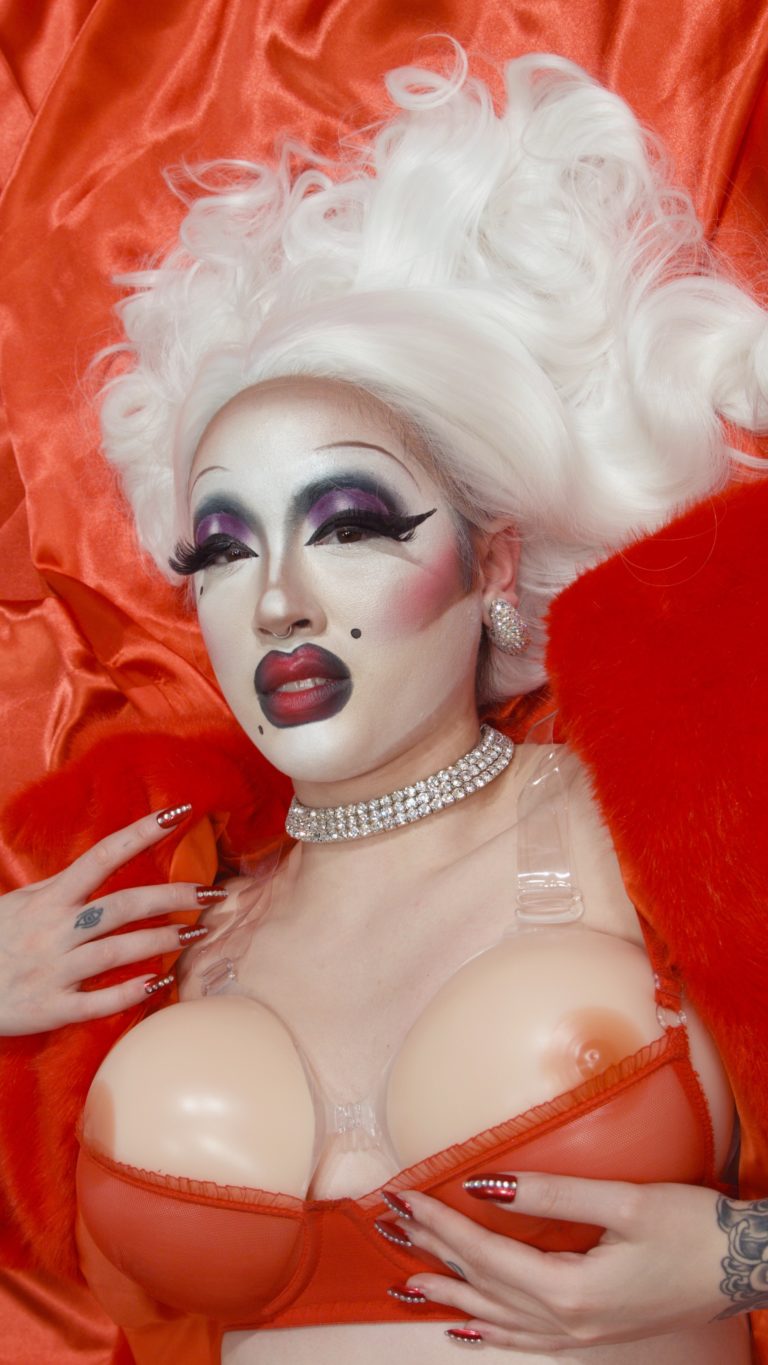 Victoria Sin, Preface/Looking Without Touching chapter (still, detail) from Narrative Reflections on Looking, 2017. Digital video, 11 min overall. Courtesy the artist/Chi-Wen Gallery and MOMENTA.
Victoria Sin, Preface/Looking Without Touching chapter (still, detail) from Narrative Reflections on Looking, 2017. Digital video, 11 min overall. Courtesy the artist/Chi-Wen Gallery and MOMENTA.
ER: Speculative fiction uses aliens as “other,” but places them in a world where they are the majority. This has me thinking about what your relationship is to “other” because you straddle so many cultural lines. You’re a mixed-race, expatriate, non-binary, assigned-female-at-birth drag queen, and I think your drag performance is a physical representation of that straddle. Does that in-between place have a correlation with creativity?
VS: Definitely. Being somewhere in between, not really being able to locate myself in so many different areas of my life, has really informed my work. It’s made me see that gender is a construct, that nationality is a construct, and that these in-between positions are a lot about uncertainty and being comfortable with not knowing. Humans are animals that really love to be certain about things, that love to be able to draw a line around something and say, “This is what I am, this is what you are.” So to be able to say “No, I am neither of those things” has been something I’ve struggled with, but I’ve realized it’s a very important act. I try to write from a non-binary, “othered” position in all senses. I’m not trying to claim anything, I’m just trying to show the audience that their positions are maybe not what they think they are.
The performance I’m doing in November at MOCA is a performance I did at the Venice Biennale and at Chi-Wen Gallery. It’s a performance that’s basically a duet with an instrumentalist. Every time I perform it, I work with a different instrumentalist and instrument. It’s about language, which is of course a category-producing technology. When you are speaking, you are naming things, and when you’re naming things, you are creating delineations of what things are and aren’t. The performance is about the difficulty of naming, of this double-edged sword. It’s often violent to name things but also liberating to be able to name yourself. But by naming yourself, you are still creating a line, saying, “This is what I am”; it becomes incredibly difficult to step outside of that. In my performance, a name is replaced by a musical note or musical sentence. It creates a blank space that is not so easily categorized and is much more emotional.
It’s about language, which is of course a category-producing technology…The performance is about the difficulty of naming, of this double-edged sword.
ER: You’re also releasing music later this year with Shy One. What is that project like?
VS: They’re mostly projects we’ve been working on together, essentially my texts with her music. Working with Shy One has been amazing because she’s also my girlfriend, so some of the texts are about her. They are really intimate, and some are super sexual. The way that she’s built the tracks are really personal and I think that’s apparent when you listen to them.
ER: What’s it like hearing her reaction to your work through music?
VS: Incredible. That’s why I fell in love with her. When we first started hanging out, I sent her a few things that I had written and recorded. She sent them back to me as full songs, and the way she had interpreted my words and created layers and textures completely brought it alive. I thought, “If this is how you understand my work, I just want to hang out with you all the time. In every sense.”
ER: When is the album coming out?
VS: We don’t have a date yet. We are working on something right now with Yaeji that will be released on her next mixtape, which I think will come out in the next few months.
ER: It must be liberating to explore so many different mediums.
VS: Definitely, I have learned so much from the different musicians I’ve worked with. I’m really interested in the way that music and sound bring emotion and nuance to my work. I want to use every kind of theatrical or filmic technology I can to create worlds that people can be completely immersed in.
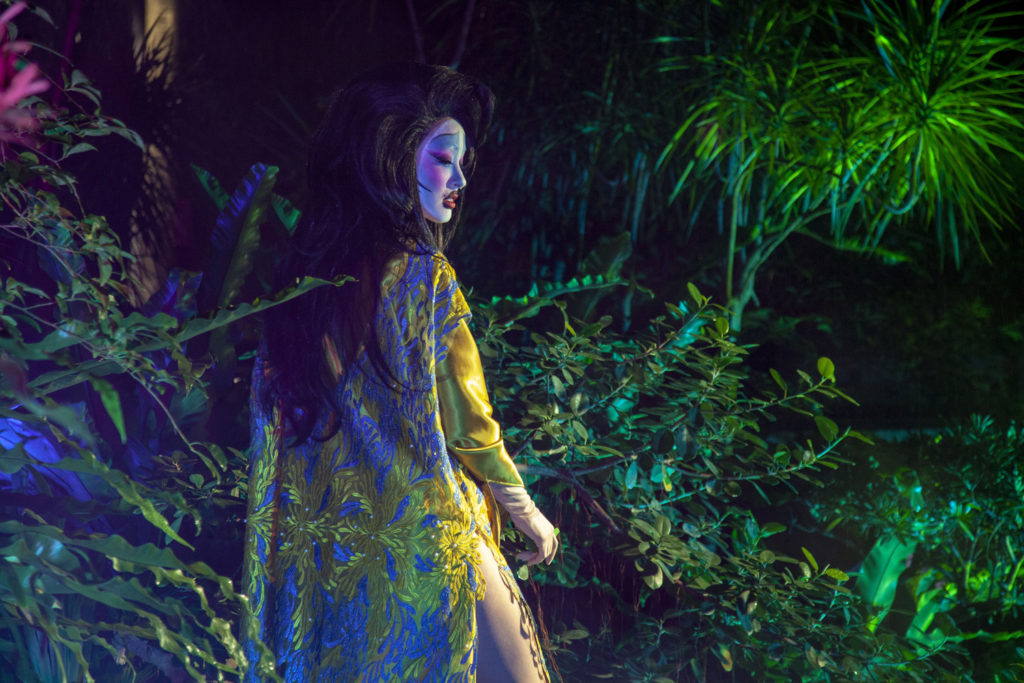 Victoria Sin, If I had the words to tell you we wouldn’t be here now (performance documentation), 2019, at Chi-Wen Gallery, Taipei. Photo: Ivy Tzai. Courtesy the artist/Chi-Wen Gallery.
Victoria Sin, If I had the words to tell you we wouldn’t be here now (performance documentation), 2019, at Chi-Wen Gallery, Taipei. Photo: Ivy Tzai. Courtesy the artist/Chi-Wen Gallery.
ER: What would you say to someone entering the world of experimental drag?
VS: I think it would depend on where they are, because if you’re in a small town or if you’re in a global centre, getting into drag—especially experimental drag—can be really difficult. In some places, it can be dangerous. Drag is so much about the person; every drag artist is completely unique and does it for different reasons.
ER: Then what would you say to someone who’s seeing experimental drag for the first time?
VS: I would say be open and consider it. Consider what this means to the person doing it, and also the people who are watching it. I think one of the best things about drag is that it’s a mirror. Don’t make immediate judgments. Take time to reflect on it, and use it to reflect on yourself.
Victoria Sin will perform If I had the words to tell you we wouldn’t be here now at MOCA Toronto for “Age of You” on November 28 with percussionist Nikki Joshi. The exhibition is on until January 5, 2020.

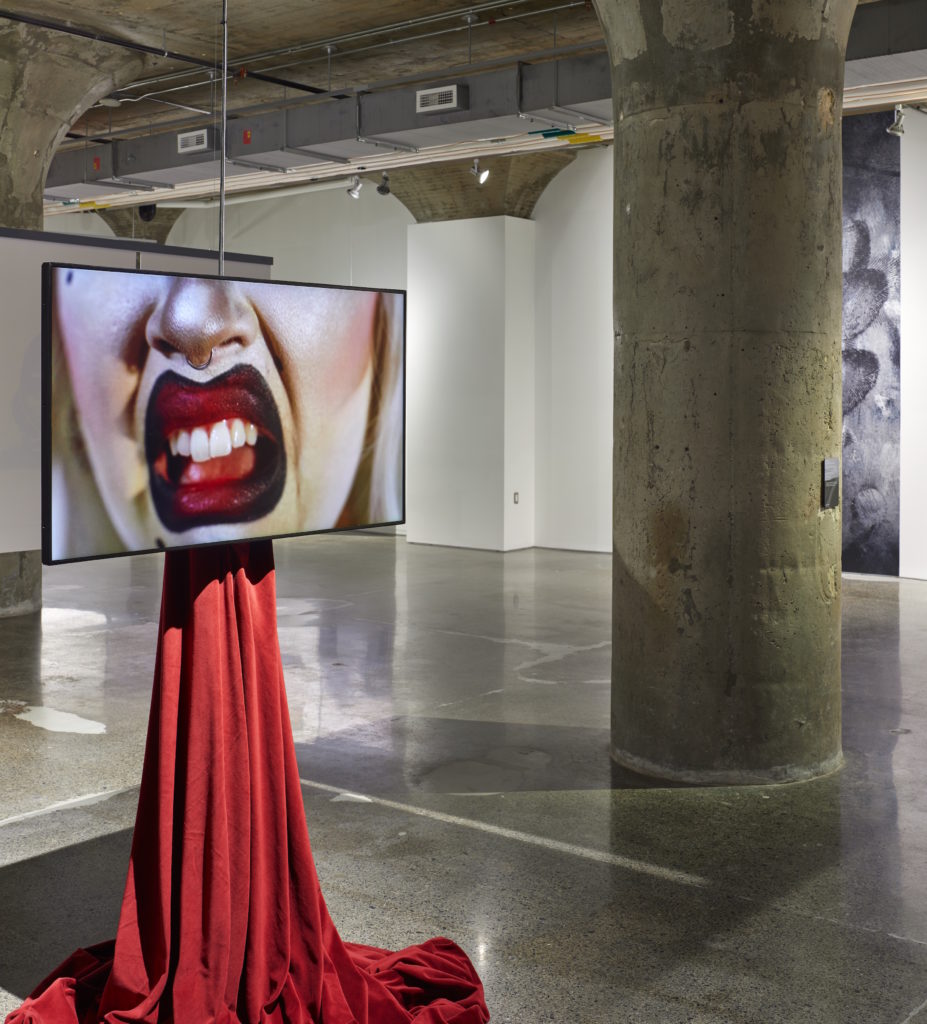 Victoria Sin, Illocutionary Utterances (installation view), 2018. In “Age of You,” MOCA Toronto, 2019. Photo: Tom Arban Photography Inc.
Victoria Sin, Illocutionary Utterances (installation view), 2018. In “Age of You,” MOCA Toronto, 2019. Photo: Tom Arban Photography Inc.
